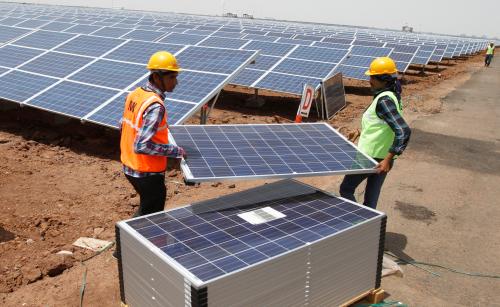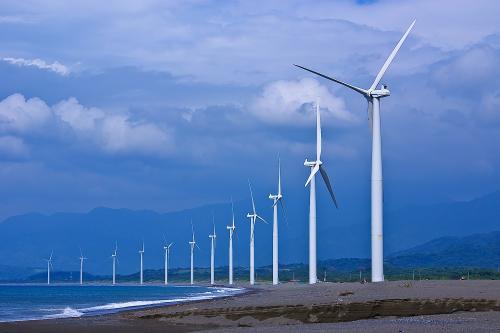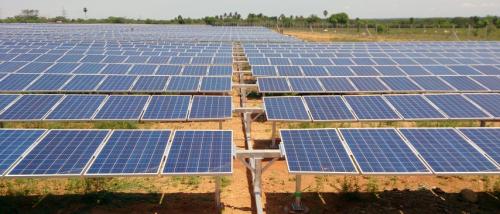Content from the Brookings Institution India Center is now archived. After seven years of an impactful partnership, as of September 11, 2020, Brookings India is now the Centre for Social and Economic Progress, an independent public policy institution based in India.
This article is a part of India 2024: Policy Priorities for the New Government, a compendium of policy briefs from scholars at Brookings India, which identifies & addresses some of the most pressing challenges that India is likely to face in the next five years.
India’s policy default in the energy sector has been a focus on infrastructure addition with the goal of sufficiency. This made sense based on the deficits it was facing after Independence, especially in the electricity sector. Reliable and assured energy is also a prerequisite for robust industrial and manufacturing growth. But now, India has reached a situation of aggregate electricity surplus, and barring occasional upheavals, aggregate fuel security for the industrial sector. The emerging challenges in energy pertain to allocation, efficiency, and resolution between the multiple goals and consequent stresses the energy sector should address. These require a revamp of the traditional approach to energy policy, which has viewed the system as supply-constrained as a starting point.
Improve Energy Productivity and Valuation
Historically, the demand side of the Indian energy scenario has not received the attention it deserves. Instead, the political agenda of energy has been limited to two broad metrics: affordability and supply infrastructure addition. India continues to face the mammoth challenge of shifting much of its rural populace to modern cooking fuels, and providing affordable and meaningful electricity for the energy and income poor. This shift to commercial energy will increase India’s energy and emissions profile such that the greenhouse gas emission intensity of India’s energy portfolio will rise by over 10% by 2030, notwithstanding the ambitious domestic targets on renewable energy.
This means that the bulk of the onus of achieving emissions reductions (even beyond India’s nationally determined contribution) lies in energy productivity—enhancing the GDP per unit of emitted greenhouse gases over time. The next government faces a sizeable opportunity to shift the focus towards efficiency and service delivery. The task will also involve work towards changing public mindset towards efficient provision of affordable and reliable energy services. A good example of this process was the ‘Give it Up’ campaign on LPG subsidy that emphasised the role of the well-off sections of society in becoming conscientious stakeholders in national development.
However, currently, there are a number of gaps in valuing energy efficiency. A unit of energy saved will always be more valuable than a unit produced, due to technical losses. In industries and commercial enterprises where the energy prices are high enough to impact bottom-lines, energy efficiency investments are autonomous, yielding returns over a shorter payback period. For households, a combination of high sensitivity to front costs of appliances, coupled with unrepresentative pricing structures (especially for the densely consuming urban ‘middle class’) has resulted in only a very gradual uptake in energy efficiency. Even in agriculture, while most states decree free or one-time flat-rate based supply, the benefits are concentrated within the relatively well-to-do households owning sizeable farmland.
Related to the above is the absence of adequate signalling to end-users about power costs during peak and off-peak times. This is coupled with the lack of direct load shifting or demand response options, except in agriculture, where supply hours are traditionally fixed to off-peak early morning hours. With high Renewable Energy (RE) penetration, demand response is the most cost-effective option to ensure efficient utilisation of clean energy, and must be pursued on priority. Therefore, the policy on energy valuation on users’ end must provide mechanisms to signal or adapt to the following differentials: the value of a unit saved versus a unit generated; capacities and motivations among different end users to invest in energy efficiency; and peak and off-peak power.
Employ Meaningful Targets
Successive Indian governments have set highly optimistic energy sector-related targets. From RE, to electric vehicles to even natural gas, the policy ambitions set by this government should be understood as intention signalling rather than hard targets. Even so, the targets themselves need to be revisited to become more meaningful and service-oriented. On electricity access, for example, the conversation (and targets) must shift towards expanding energy provision.
Even for schemes such as Ujjwala, a mere headcount of beneficiaries is no indicator of the quality of service or the scheme’s success in causing rural customers to switch from non-commercial biomass to LPG. Deriving service-based targets that measure real and durable change is arguably much harder, as it requires a careful assessment of prevailing conditions or circumstances that act as enablers or otherwise. One such approach has been proposed by UN’s ‘sustainable energy for all’ in the context of tiered measurement of electricity access. This allows for measuring granular improvements along the arc of time rather than mere headcount variables at different points of time. For example, a solid indicator of meaningful access is if the electricity consumption profile of a newly electrified village indicates progressively more sophisticated and productive uses beyond lighting, fans, and charging, or if the hours of supply (including peak hours) show improvement.
Manage Multi-Dimensional Priorities
For every technology-policy choice, there is an alternative. Each alternative may impact several objectives in the energy sector differently: energy security, low-carbon, reliability, affordability, job creation, etc. When the government directly intervenes in picking a favourite option, how are these objectives accounted for? Top-down policies need a clear statement of vision and aims that can be evaluated against the stated rationale and expected outcomes. This helps to prevent a closing down of conversation related to alternate policy pathways that may score better on the multiple objectives.
As an example, high electric vehicle (EV) future and a marriage of EV and RE may be some way down the line, contingent on multiple developments, and even then may turn out to be expensive. In the interim, how do we step up engine and fuel efficiency, public transport, CNG availability, last-mile mobility and complementary measures that enhance the future of safe, affordable, and sustainable transport in India? The amount of government support by way of subsidies and incentives to such measures must, therefore, align with the quantum of benefits accrued on the multiple objectives.
Lastly, no sector is in greater need of smarter policies than thermal power plants reeling under the stressed asset build-up. So if the objectives are obtaining cleaner and flexible power at least cost, pollution norms should target aggregate outcomes rather than individual units. Similarly, curbing the growth of coal import share in thermal generation requires concrete steps towards enhancement of domestic coal quality, allocation, and linkages, than simply trying to mine more coal.
The grand challenges of the past are giving way to more nuanced and complex issues as India moves up the energy and development ladder. The incoming government faces a unique opportunity to ride on the ongoing transition, and change some of the archaic and arguably counter-productive notions and practices that have stalled energy policy in India. With the question of aggregate supply now largely resolved, issues of allocative efficiency and productivity should become the focus.
The Brookings Institution is committed to quality, independence, and impact.
We are supported by a diverse array of funders. In line with our values and policies, each Brookings publication represents the sole views of its author(s).




Commentary
India 2024: A productive India
May 17, 2019